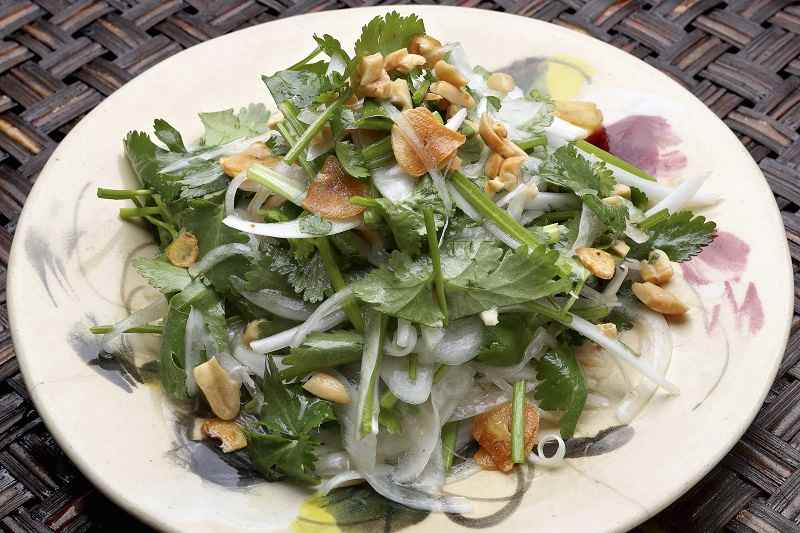
Steamed shrimp and vermicelli
12:40 JST, April 5, 2022
With the pandemic making going abroad for fun practically impossible, why not try some exotic food at home and go on a culinary global adventure?
Cooking specialist Wakako Sato, who is well-versed in the world’s cuisine, said a Thai dish of steamed shrimp and vermicelli is a nice choice.
Sato studied Thai cuisine at Thai restaurants in Tokyo and in Thailand. The dish, in which vermicelli and shrimp are steamed in broth, is often found in Thai restaurants in Japan.
Using sweet-smelling coriander root to bring out the dish’s unique flavor is the key to its deliciousness, Sato said. The herb is known as “pakuchi” in Japan, which is derived from its name in Thai.
When buying coriander, Sato recommends choosing a plant with roots, even if it is a small amount. Two centimeters of root should be enough, she said.
Cut the root off from the coriander plant first and crush them with the handle of a knife. When chopped up, they smell kind of sweet, similar to the smell of citrus fruits.
“Various parts of coriander have different aromas and are used in different ways,” Sato said. “The leaves are to be eaten raw. The stems are good as ingredients for soup, and the roots for stewing.”
Steamed shrimp and vermicelli
Ingredients (serves 2):
50 grams dried mung bean vermicelli
4 whole shrimp
30 grams pork belly
15 cm piece celery stalk and some leaves
100 grams bean sprouts
2 cloves garlic
1 clove ginger
20 grains black pepper
2 cm piece coriander root and some leaves
1 tsp oyster sauce
1 tsp soy sauce
1 tsp brown sugar or cane sugar
½ tsp nam pla fish sauce
2 tsp sesame oil
80 ml water
½ tsp chicken stock powder
Directions:
1. Rehydrate the mung bean vermicelli in warm water and drain. Cut the back of the shrimp and devein. Shelled shrimp with the back wide open heats up quickly. Cut the pork into strips. Remove strings from the celery stalk and slice it diagonally. Remove root hairs from the bean sprouts.
2. Crush the coriander root and garlic with the handle of a knife and chop. Chop the ginger. Place them in a bowl and mix with crushed pepper, oyster sauce, soy sauce, nam pla fish sauce, sesame oil and brown sugar.
3. Add the vermicelli to the mixture and toss to coat.
4. Spread the pork belly on the bottom of a small pot, and top with half of the mixture, the shrimp and the celery stalk in that order. Add the remaining mixture and pour the chicken stock powder-dissolved water. The pork belly at the bottom of the pot can prevent other ingredients from burning.
5. Cover the pot, place it over high heat and bring to a boil. Lower the heat to medium, steam for 10 minutes and turn off the heat. Add the bean sprouts, cover again and let sit for one minute with a lid. Mix together, serve the ingredients on a plate and garnish with chopped celery and coriander leaves.
The dish had a rich flavor enhanced with shrimp’s umami, coriander’s refreshing aroma and a hint of pepper. It would surely make you want to visit Thailand to try some there.
Refreshing coriander salad

Coriander and seasonal onion salad
Leftover coriander can make for a refreshing salad with seasonal onion. Chop the coriander, thinly slice the onion and soak it in water. Put a little oil and sliced garlic in a frying pan, and heat over low heat. Once the garlic is golden brown, put the oil in a bowl. Add nam pla fish sauce, sugar, lemon juice and chili powder. Mix them with the coriander, onion and chopped peanuts. Place the ingredients on a plate and serve with garlic.
"Features" POPULAR ARTICLE
-

Sanrio to Open Museum in Yamanashi Pref. Dedicated to Founder, Exhibits Include Hello Kitty, Other Characters
-

Autumn Foliage Surrounds Visitors to Tokyo’s Showa Kinen Park
-

My Daughter No Longer Speaks to Me, But I Want to See Her and My Grandchild
-

Kumamoto: Public Bath Refurbished as Library Where You Can Chat, Take Photos
-

Frozen Vegetables: Demand Rises for Convenient, Tasty Domestic Produce
JN ACCESS RANKING
-

Keidanren Chairman Yoshinobu Tsutsui Visits Kashiwazaki-Kariwa Nuclear Power Plant; Inspects New Emergency Safety System
-

Imports of Rare Earths from China Facing Delays, May Be Caused by Deterioration of Japan-China Relations
-

University of Tokyo Professor Discusses Japanese Economic Security in Interview Ahead of Forum
-

Japan Pulls out of Vietnam Nuclear Project, Complicating Hanoi’s Power Plans
-

Govt Aims to Expand NISA Program Lineup, Abolish Age Restriction




















